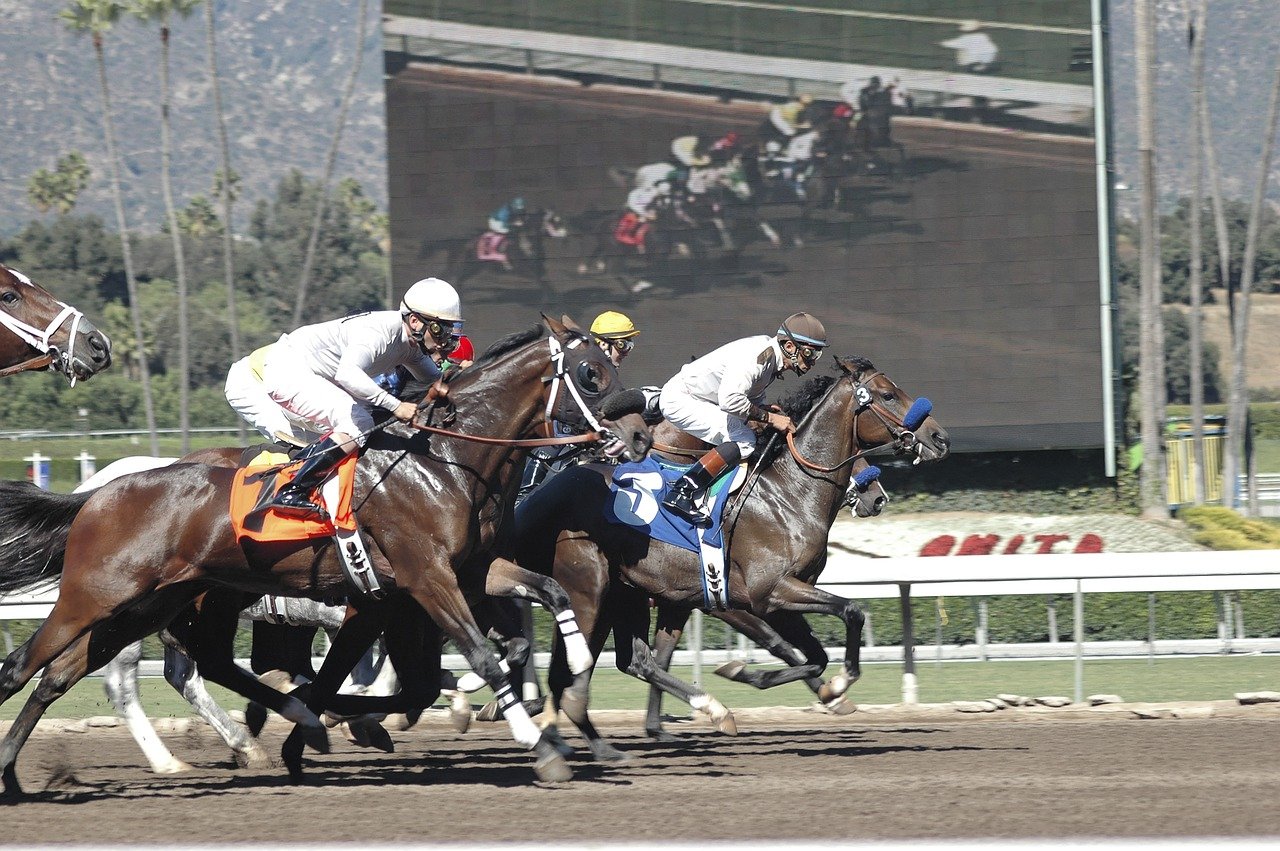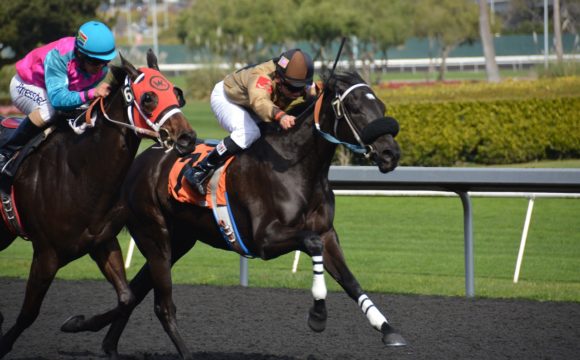When you first start betting on horseracing, you’ll notice that there are a number of different types of race that you can bet on.
Horseracing in the UK is divided into three main types of race: Jump racing (or National Hunt), Flat-racing and All-Weather racing.
Types of Jump Race: The Steeplechase
Steeplechases are usually run over a distance of between 2 and 4 miles and have larger jumps than those in a Hurdle. The jumps on a Steeplechase course must be at least 4.5 feet high and are fixed, so that they don’t collapse like those in a Hurdle. Steeplechases are therefore more suitable for more experienced horses and horses cannot take part in Steeplechases until July 1 in the year of their fourth birthday. The most famous Steeple Chase in British horseracing is the Grand National, which is held annually at Aintree. The Cheltenham Gold Cup is also a Steeple Chase.
Types of Horse Race: The Flat Race
Flat races are races in which the horses race over a long stretch of grass with no fences, open ditches or water jumps. The season runs throughout the summer and autumn. Flat-racing courses are usually shorter than jump-racing courses. Epsom is a flat racing course.
Types of Horse Race: The Jump Race
Jump Races are also often known as National Hunt races and are races in which horses have to jump over obstacles such as fences, ditches and water jumps. Traditionally the jump-racing season has taken place during winter and spring, but nowadays the season runs for longer than this.
Essentially there are two main types of jump race: the Steeplechase and the Hurdle.
Types of Jump Race: The Hurdle
Hurdles are run over a minimum distance of 2 miles but can be run up to a distance of about 3 miles. The jumps in a Hurdle race must be at least 3.5 feet high but they tend to be smaller than jumps in Steeplechase races and collapse more easily. Therefore, Hurdles tend to be more suitable for less experienced horses than Steeplechases, although horses cannot take part in Hurdles until July 1 in the year of their third birthday. Famous Hurdle races include the Stan James Intermediate Hurdle which is held at Newbury’s Hennessey Meeting, and the Champion Hurdle which is held at the Cheltenham Festival.
Check the top racing bookmakers page for introductary offers and claim your free £10 bet
Types of Horse Race – The All-Weather Race
All-weather horse racing is a relatively new type of racing in the UK. Horses race in purpose-built all-weather racing stadiums on artificial ground. Although all-weather races can be run throughout the year, they are generally run in the winter. There aren’t many all-weather tracks in the UK at the moment, but more are being built so all-weather races are likely to become a more regular feature of the British horseracing calendar.
Although flat racing, jump racing and all-weather racing are the three main categories of horserace in the UK, there are also many other types of race that you will come across within these categories.
Classifications of Horse Race
The British Horseracing Board (BHB) classifies different races into categories based on the race value and the ratings of the horses that can compete so that races can be compared to each other. Traditionally, the highest class of horse race was the Group race. Group races were divided into Group 1, Group 2 and Group 3 races. The second highest class was the Listed race, which were known as classification A races. Lower level races were then categorised as B, C, D, E, F, G or H.
In 2005, the BHB changed these classifications. The new categories are as follows:
Class
Race Type
1
Includes races previously categorised as Groups 1, 2 and 3 and the Listed races previously classed as A
2
Includes races previously classed as B
3
Includes races previously classed as C
4
Includes races previously classed as D
5
Includes races previously classed as E
6
Includes races previously classed as F and G together with some Selling races, Apprentice races and Amateur races
7
Includes races previously classed as H. These races are also sometimes referred to as Banded Stakes or Regional Racing.
Not all horseracing websites use the new classifications, so you may find races are shown using either system.
Here are some of the other types of horse race you might come across:
Types of Horse Race – Amateur Races
A horse race which is only open to amateur jockeys. You can spot an amateur rider on your race card because his or her name will be prefixed by their title, e.g. Mr, Mrs, Miss etc.
Types of Horse Race – Apprentice Races
Apprentice races are only open to apprentice jockeys. Apprenticeship to a stable is the first stage in becoming a flat-racing jockey. The jump-racing equivalent of an apprentice is known as a conditional jockey. Apprentices are sometimes allowed to claim weight allowances depending on the rules of the specific race and their own racing experience.
Types of Horse Race – Bumper Races
Although National Hunt races are usually jump-races, there are also National Hunt Flat Races, known as “bumpers”. Bumpers usually feature young horses and are designed to give them experience. Traditionally, bumper races also tended to feature amateur jockeys, but now you will find experienced jockeys competing as well. The most famous bumper in British horseracing takes place at the Cheltenham Festival.
Types of Horse Race – Claiming Races
Claiming races are races which are essentially used to buy and sell horses as the horses running in a claiming race can be bought (or “claimed”) by another trainer after the race. In claiming races, the trainers effectively give their own horses a handicap of their choice, as the horses are weighted to reflect their perceived value.
There is a set maximum selling price for each claiming race, and if trainers are happy to set a lower value for their horse, they can reduce the amount of weight the horse is carrying by specific amounts in order to reflect this lower price. For example, if the maximum selling price was £15, 000 and horses were allowed a weight reduction of 2lb for every £1,000 under the maximum selling price that they were valued, a trainer valuing his or her horse and £13,000 could race the horse carrying 4lb less.
Sometimes, particularly in the UK, claiming races are used primarily to give horses a chance to win, as the current owner can also claim the horse for themselves at the end of the race. However, they are becoming more popular as a genuine way of selling racehorses.
Types of Horse Race – Conditions Race
In this type of horse race, the horses carry set weights depending on specific factors such as their age, sex and racing history. Races which are not classed as handicap races are conditions races. One of the most famous conditions races is the Epsom Derby. Conditions races are also sometimes referred to as Weight-for-Age races.
Types of Horse Race – Handicap Races
In handicap races, horses of different abilities compete against each other, so in order to make the race fairer and more entertaining, each horse is allocated a weight to carry depending upon its ability.
In most cases, the handicaps are based on a horse’s official rating, which is checked after each race it takes part in and may change depending on how well it has done. The ratings are stored on computer at Weatherby’s, and when a horse competes in a handicap race, the computer allocates an appropriate handicap, which is then checked by the official handicapper. The official handicapper also allocates handicaps to competing horses that don’t have an official rating.
The horse with the highest rating is allocated the top weight available, and all other horses are allocated weights in comparison to that depending on ability.
Types of Horse Race – Hunter Chases
Hunter chases are steeplechases which are only open to horses which have been hunted regularly and are qualified to compete in point-to-point races.
Types of Horse Race – Maiden Races
Maiden races are for horses that have not previously won a race.
Types of Horse Race – Novice Race
The term Novice race is usually applied to National Hunt jump-races, and means that the race is only open to horses that have not won that particular type of race (e.g. steeplechase or hurdle) prior to that season.
Types of Horse Race – Nursery Races
Nursery races are handicap races for 2 year-old horses.
Types of Horse Race – Point-to-Point
Point-to-Point races are steeplechases which are only open to amateur jockeys. The Point-to-Point season runs from January until June each year. Sometimes Point-to-Point races can provide you with an indication of the horses that are likely to be future jump-racing stars.
Types of Horse Race – Stakes Races
Stakes races are races that are usually run by experienced or high-quality horses and generally provide high prize money. They normally require an entrance fee, which is used to increase the size of the prize fund.
Now that you are familiar with the various types of horse races, you can find out more about the different horseracing bet types available on our Types of Horse Racing Bet page.





